Since AMD introduced Ryzen 7000 CPUs last September, it’s been clear that the series is very impressive in terms of performance, however migrating to the new AM5 platform has proved costly and for that reason fewer people than expected have jumped on board.
As a result, AMD has had to be aggressive with price cuts for the whole launch lineup which includes the 7600X, 7700X, 7900X and 7950X processors, and while that has helped, it’s only addressed part of the problem as AM5 motherboards and DDR5 memory remain expensive. Today a barebones B650 board will set you back $160, while basic X670 boards start at an absurd $260. Then you’re looking at around $150 for a 32GB DDR5-6000 memory kit, or around $180 for lower latency CL30 modules we usually use for testing.
So gamers after something like the Ryzen 7 7700X will need to spend $350 on the processor, at least $160 on the motherboard and $150 on the memory. That’s a $660 platform upgrade for an AM4 owner. But even for new system builders, in comparison you could also purchase the Ryzen 7 5700X for $200, a decent B550 board for $120 and a 32GB DDR4-3600 CL16 kit for $110, an enticing $430 combo that in many scenarios isn’t a great deal slower.
With that in mind, can AMD entice more people to the AM5 platform with more affordable non-X Ryzen CPUs?
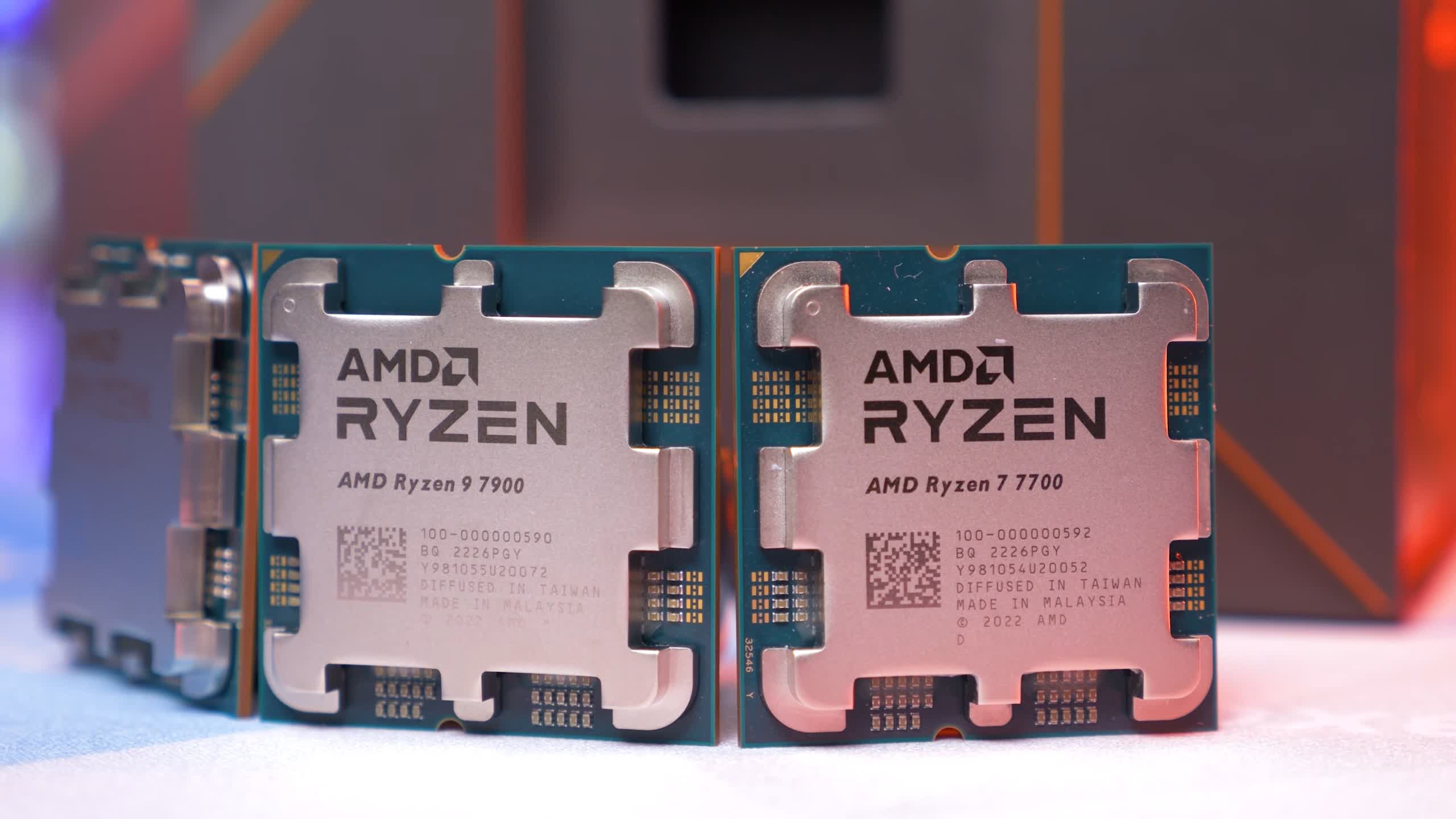
Starting at the bottom of the stack, we now have the 6-core/12-thread Ryzen 5 7600 which will be coming in at an MSRP of $230, it clocks up to 5.1 GHz (4% lower than the 7600X) and out of the box adheres to a 65w TDP. Other than that, it is basically the same part as the 7600X, it’s also unlocked so you could achieve 7600X-like performance via overclocking.
Unlike the 7600X, the vanilla 7600 does come with a box cooler, it’s only the low-profile Wraith Stealth, but it works and will save you some money on the cooler.
There’s also the 8-core/16-thread Ryzen 7 7700 coming in at $330, also a 65w part though it can clock as high as 5.3 GHz. This model comes with the Wraith Prism cooler which is actually a high quality cooler, especially for a stock one, so that’s a good deal.
Then we have the $430 12-core/24-thread Ryzen 9 7900, which can clock as high as 5.4 GHz out of the box, and also comes with the Wraith Prism.
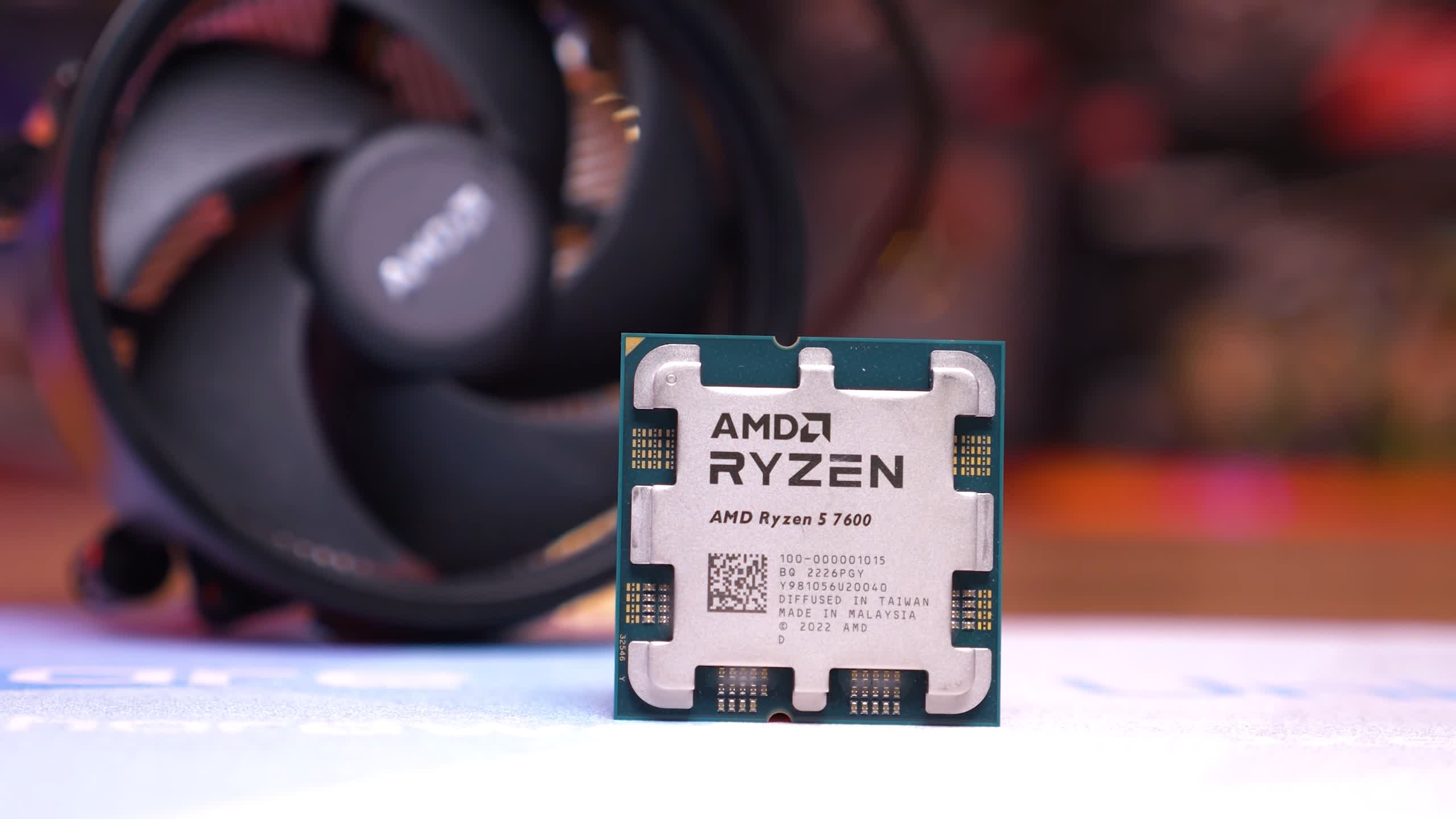
When compared to current Ryzen 7000 pricing, we find that the MSRP for the 7600 is just $20 cheaper than the lowest 7600X price available right now at $250, though most listings are back up around $300. So it would seem those temporary Zen 4 price cuts are over and replacing them are these new non-X models. The lowest price the 7600X has hit over the past few months is about $240, so the 7600 coming in at $230 with a cooler is the lowest Zen 4 deal we’ve seen yet — with room to go lower over time if history serves any lesson.
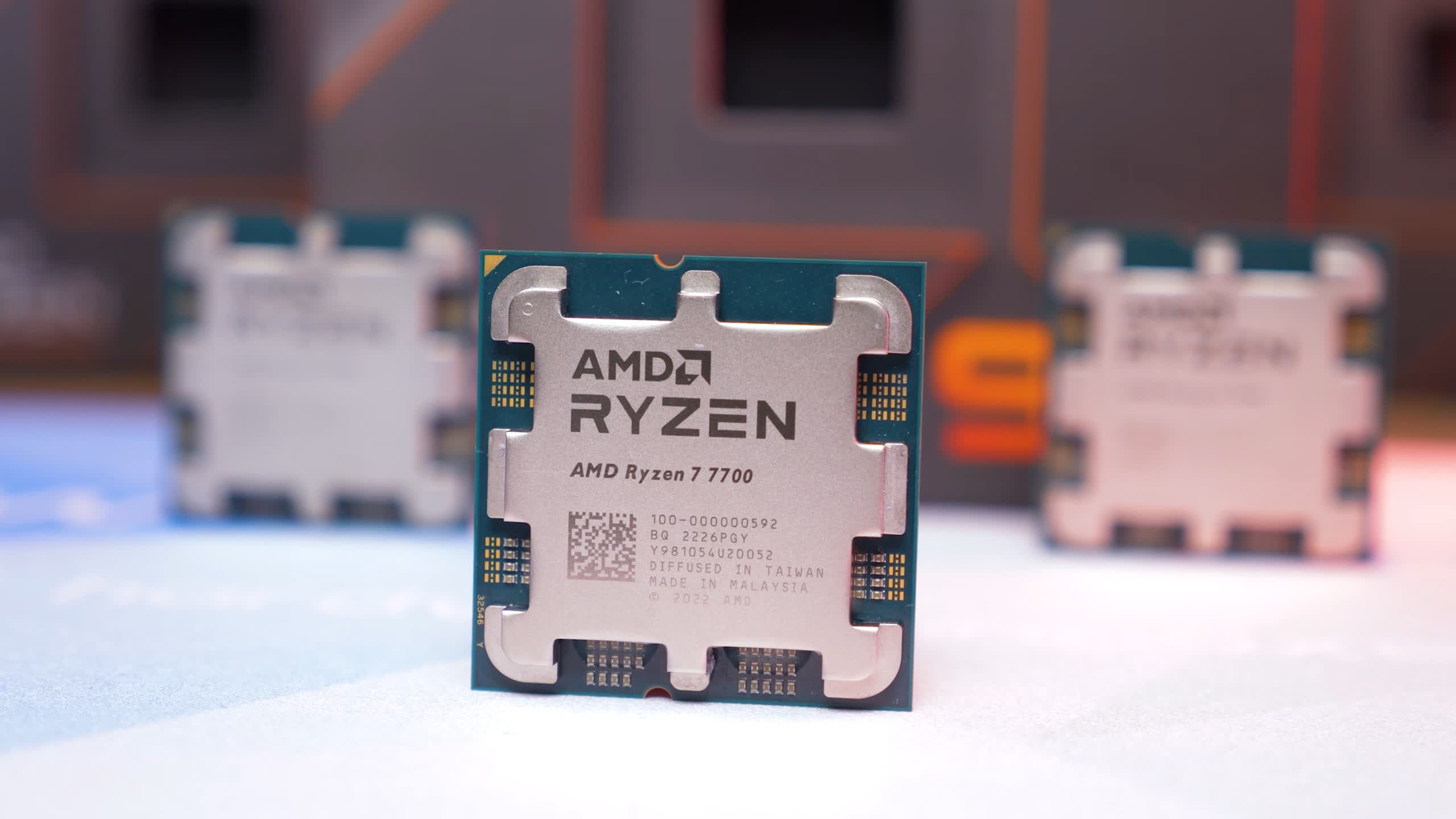
The Ryzen 7 7700X which was introduced at an MSRP of $400 was selling as low as $330 and right now can be had for $350. Therefore the 7700 which is set to cost $330 will enter the market around $20 cheaper than the X version, but you also get a quality box cooler.
Then is the 7900X, which landed with an MSRP of $550, but late last year had dropped as low as $440, but at present is closer to $480. The non-X model is quite an improvement at $430 with the Wraith Prism cooler.
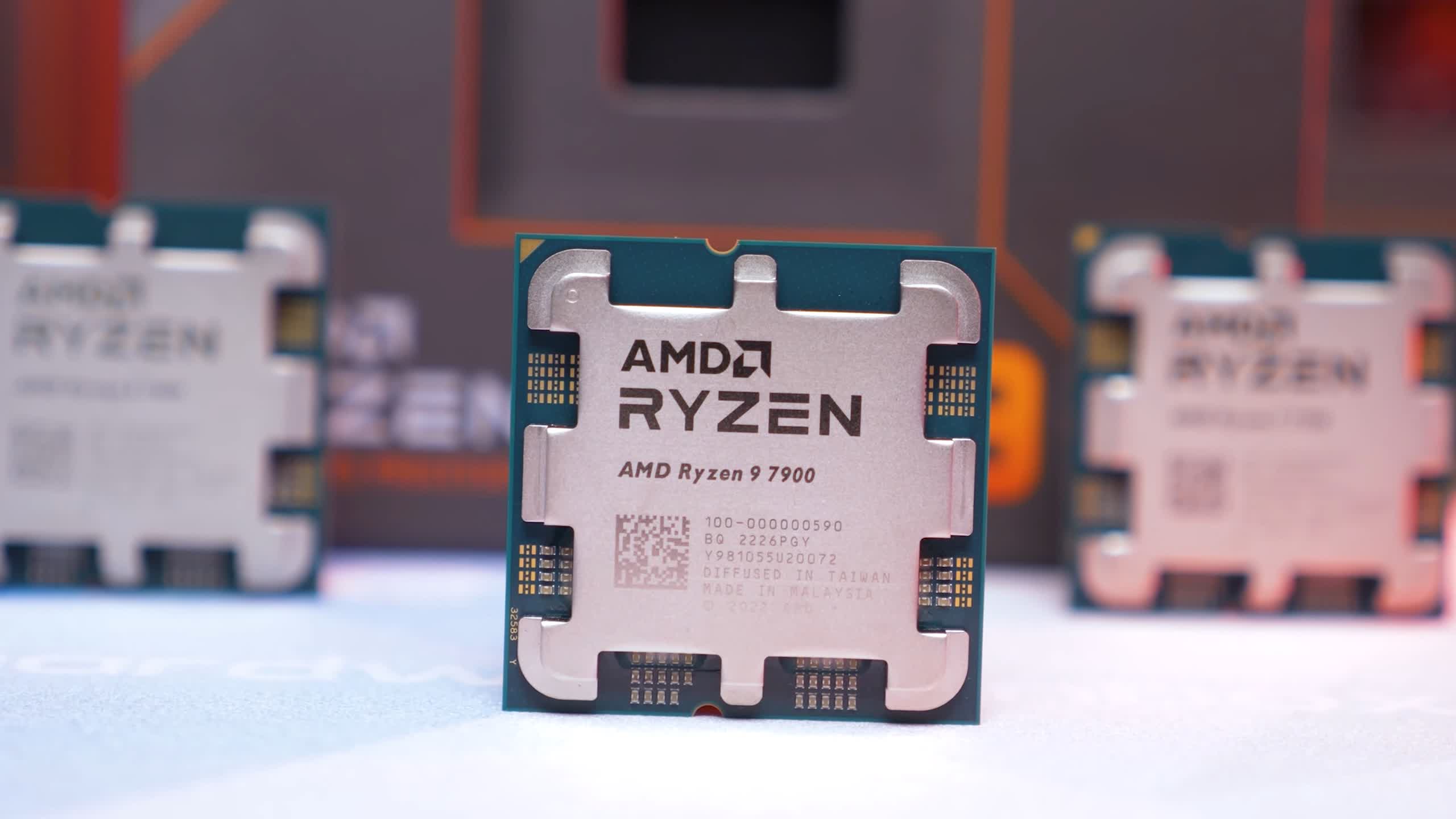
Essentially these new models allow us to re-review Zen 4 at a more affordable price point, with slightly better motherboard and memory prices, so it will be interesting to see how they stack up.
Usually we’d have quite a few application and gaming benchmarks for you, but as you’re about to see in terms of performance there’s generally very little difference between non-X and X models. So instead of spending a ton of time going over dozens of graphs that show mostly the same thing, we’ll speed up the process by reducing the amount of applications we’re going to look at while skipping most of the individual game results as well and go straight to the 10 game average. For the testing we’re using a GeForce RTX 4090, Windows 11, and resizable BAR enabled for all configurations.
Clock Speeds
Before we get into the blue bar graphs, here’s a look at the all-core behavior in Cinebench R23, starting with the 7600. By default it runs at a core power of 65w with a package power of 90 watts and this allows for a typical all-core clock frequency of 4920 MHz. Using the be quiet! Pure Loop 2 FX 360mm liquid cooler we saw a peak die temperature of 78c.
With AMD’s one-click Auto OC or PBO option enabled, the typical operating frequency for this workload only jumped up to 4995 MHz, a mere 75 MHz bump. This did increase the core power to 75 watts and the package power to 102 watts for a peak operating temperature of 83c.
Ryzen 5 7600 / PBO
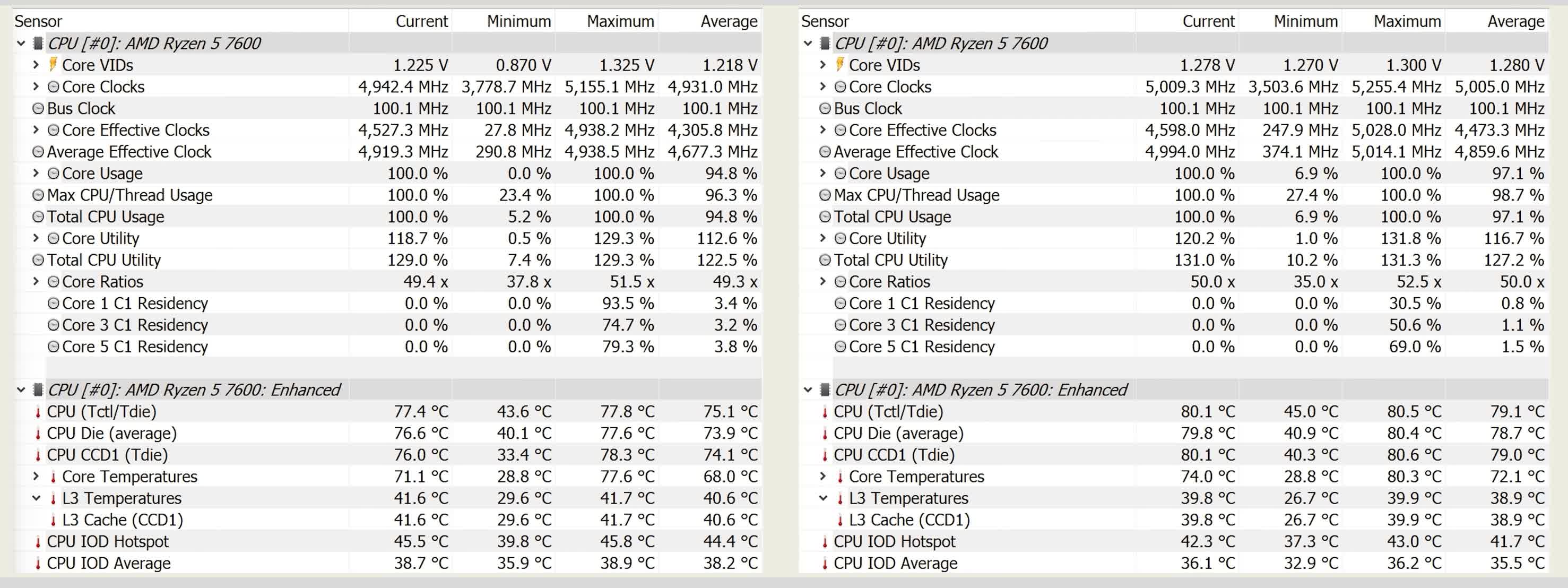
Now compare that to the 7600X which sustained an all-core frequency of 5240 MHz, 7% higher than that of the non-X part. This pushed core power to 85 watts and package power to 115 watts for an operating temperature of 89c.
Next we have the Ryzen 7 7700 which runs at 4880 MHz out of the box in this workload, resulting in a package power of 90w and an operating temperature of 67c. With PBO enabled the frequency jumped up by 3.5% to 5050 MHz and this modest frequency gain increased power usage by a massive 39% to 125 watts which also drastically increased the operating temperature to 87c. That’s quite tame when compared to the 7700X which clocks just 5% higher than the stock 7700 for an almost 60% increase in power usage, hitting 98c.
Ryzen 7 7700 / PBO
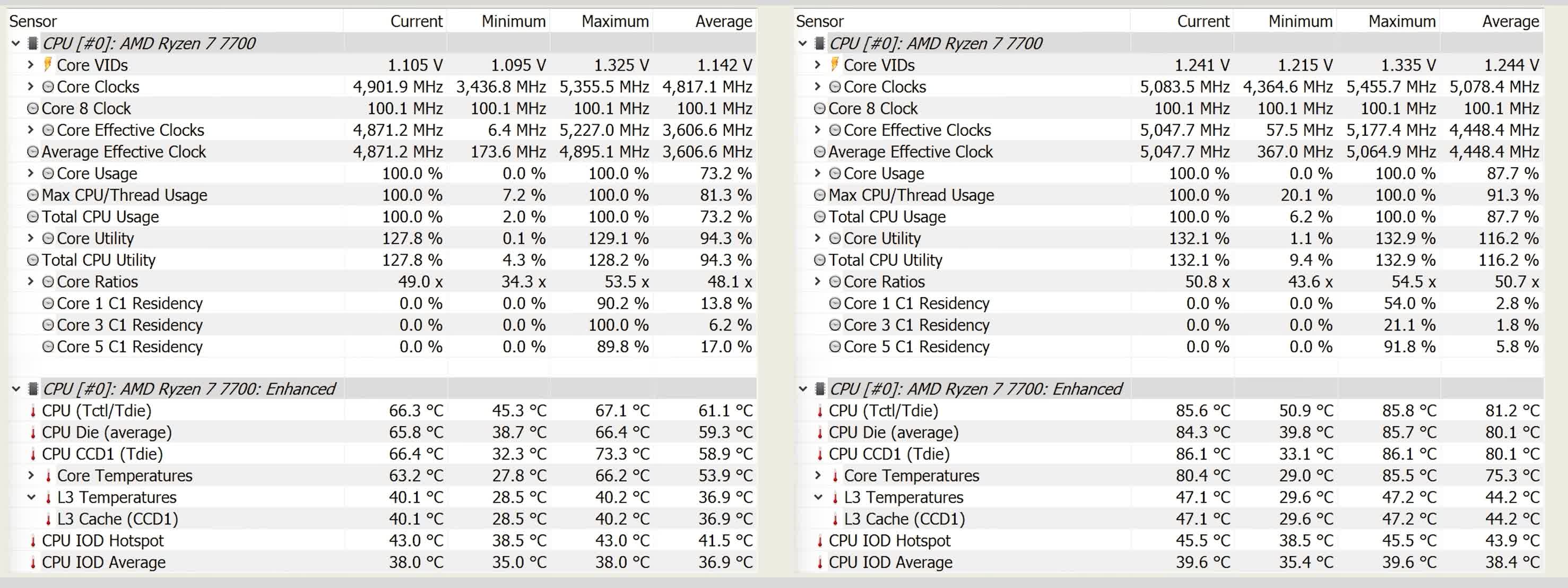
Then we have the 7900 which operates its 12 cores at an average frequency of 4415 MHz, and this was possible at a package power of just 90 watts, resulting in a peak operating temperature of just 70c.
Ryzen 9 7900 / PBO
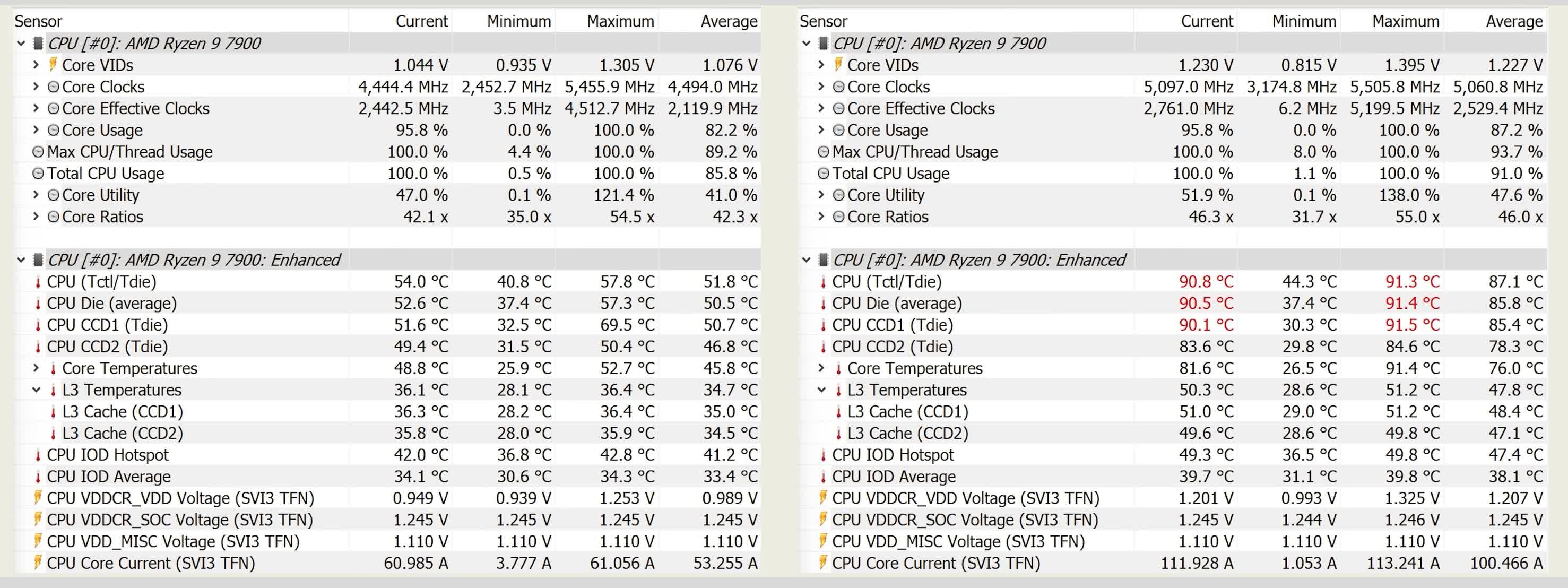
Enabling PBO boosted the operating frequency by 14% to 5050 MHz, but this also increased power usage by 91% to 172 watts for the package power, resulting in a 92c operating temperature. Finally, the 7900X ran at 5200 MHz, 186 watts for the package power and 95c for the peak temperature.
Application Benchmarks
The Cinebench R23 results confirm everything we just learned about the operating behavior of these CPUs in this same workload. The 7600 scored 14344 pts and enabling PBO boosted that score by a mere 1.5%, meanwhile out of the box the 7600 was just 4% slower than the 7600X.
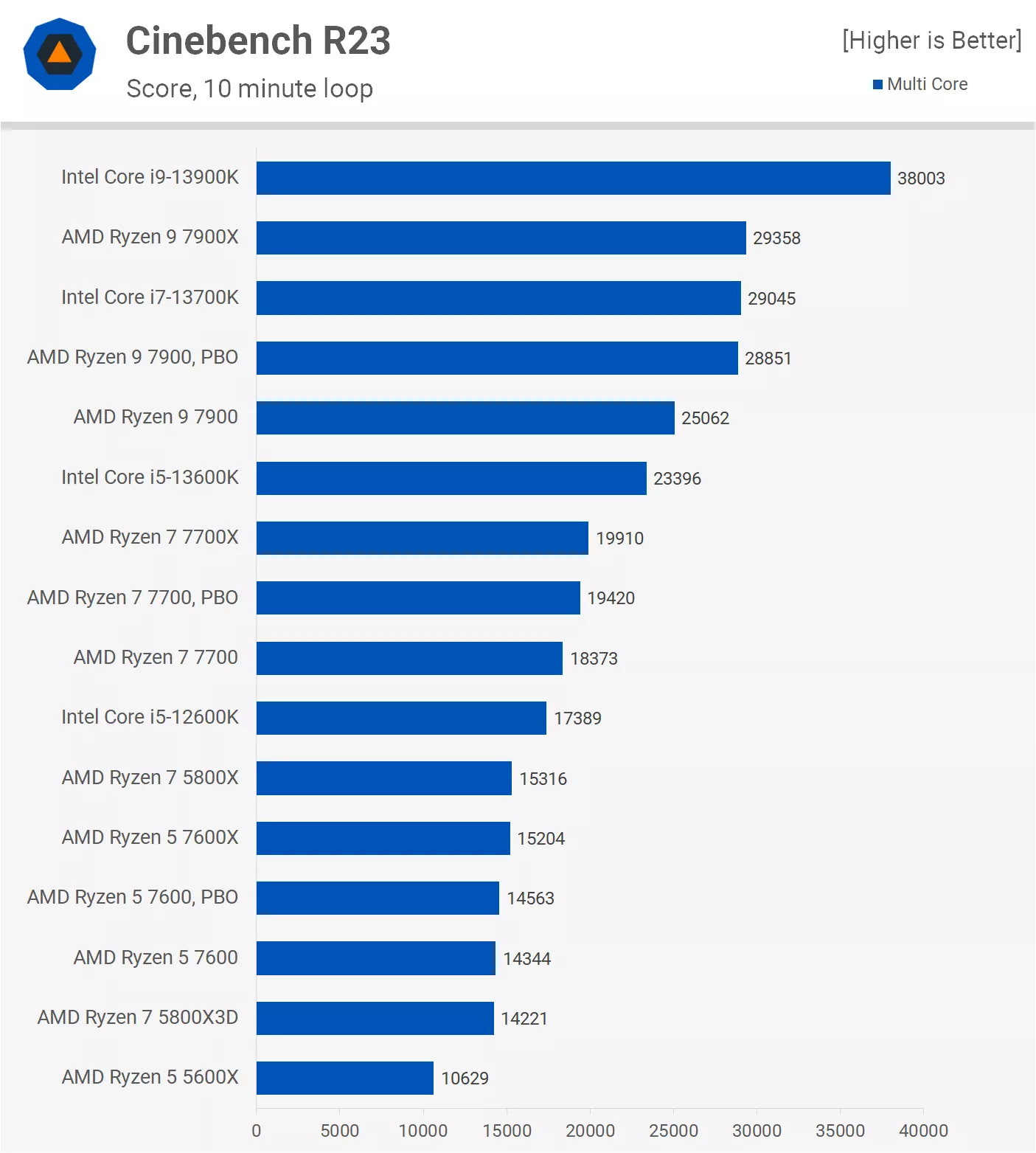
The 7700 scored 18373 pts and here PBO was more useful, improving performance by 7% to get within a few percent of the 7700X.
The 7900 scored 25062 pts making it quite a bit slower than the 7900X, though that margin was largely closed down simply by enabling PBO, making what is essentially a more efficient version of the 7900X.
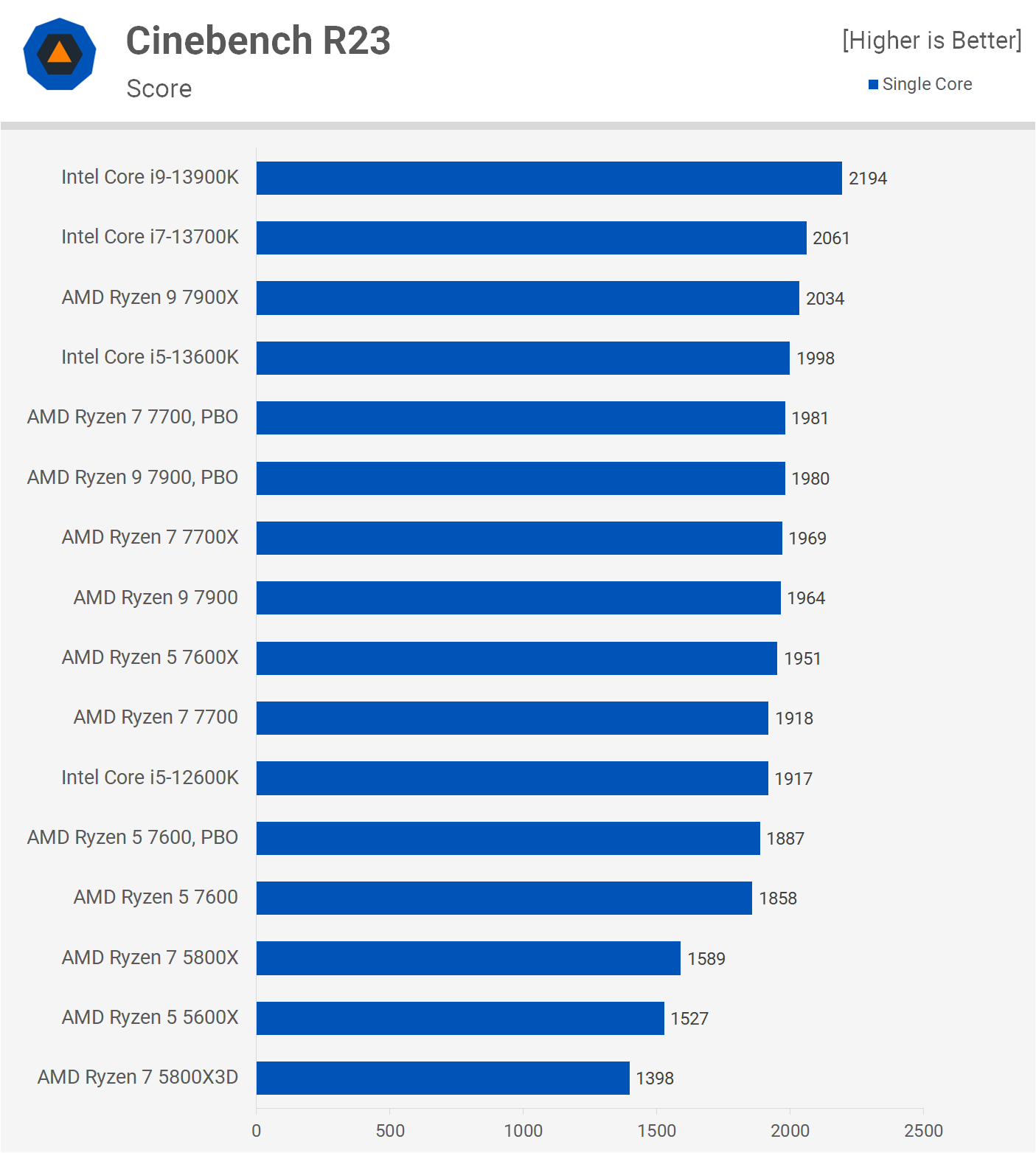
Looking at the single core performance we find that the 7600X is 5% faster than the 7600, the 7700X is just 3% faster than the 7700 and the 7900X is 4% faster than the 7900. So the margins are fairly similar, between 3-5% faster for the original X models and not a big difference. In most instances PBO does a good job of closing that small gap.

We’ll just show you compression and decompression performance for 7-Zip, but in short the margins are similar to what we saw in Cinebench R23. That is to say the 7600 was typically 3% slower than the 7600X, and the same was also true for the 7700 vs 7700X, while the 7900 was up to 8% slower than the 7900X.
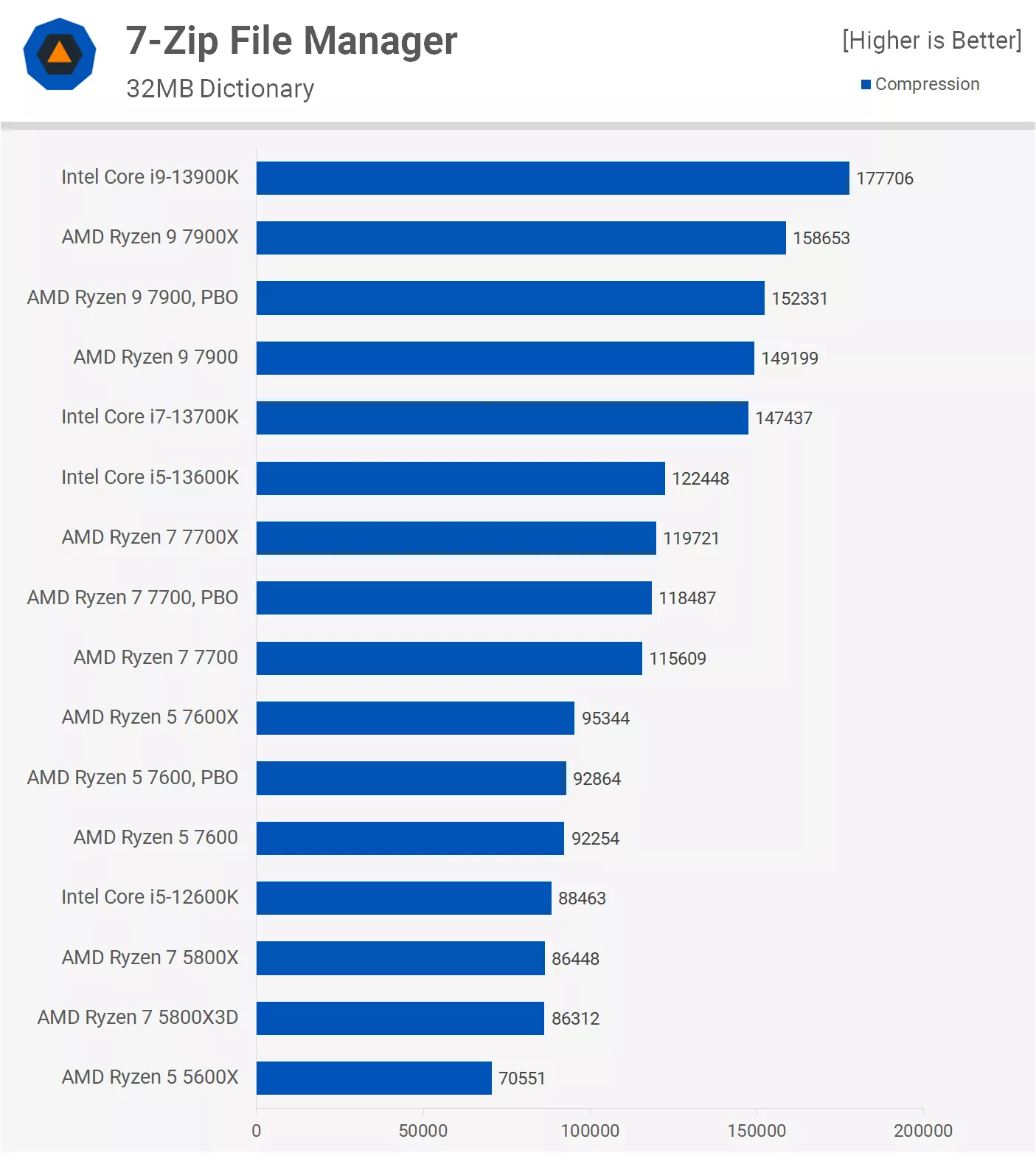

Adobe Photoshop 2022 generally only uses 1-2 cores so this is more of a single core benchmark and as such we’re seeing little difference between the X and non-X CPUs here, around a 3% margin.

Blender mimics Cinebench results with the 7600X showing up to 5% faster performance than the 7600, the 7700X is 4% faster, and the 7900X 12% faster than the 7900.
Power Consumption
Here’s a look at total system power consumption. From the 7600 to the 7600X we’re looking at a 12% increase in system consumption for a few percent extra performance, making the non-X model the more power efficient product. Then from the 7700 to the 7700X sees a 21% increase in system consumption, for again what was a ~4% performance improvement.

Then we have the 7900 which thanks to its higher core count can afford to run the cores at a much lower frequency allowing for lower voltages, and it can do this while still achieving excellent productivity performance. As a result it consumed the same amount of power as the 7600, but incredibly was 83% faster in this example.
It also meant when compared to the 7900X, the 7900 is far better when it comes to power efficiency. The 7900X pushed total system usage 50% higher for a 12% performance increase.
Gaming Benchmarks
As mentioned before, we’re just going to look at the graphs for 3 of the 10 games tested as the results are all very predictable. Starting with Hitman 3 at 1080p, we see that the 7600 is just 3 fps slower than the 7600X, the 7700 4 fps slower than the 7700X and the 7900 10 fps slower than the 7900X. It’s a similar story at 1440p, so it’s only the 7900X that offers a notable performance gain over its non-X part and even then we’re only talking about a 4% increase.
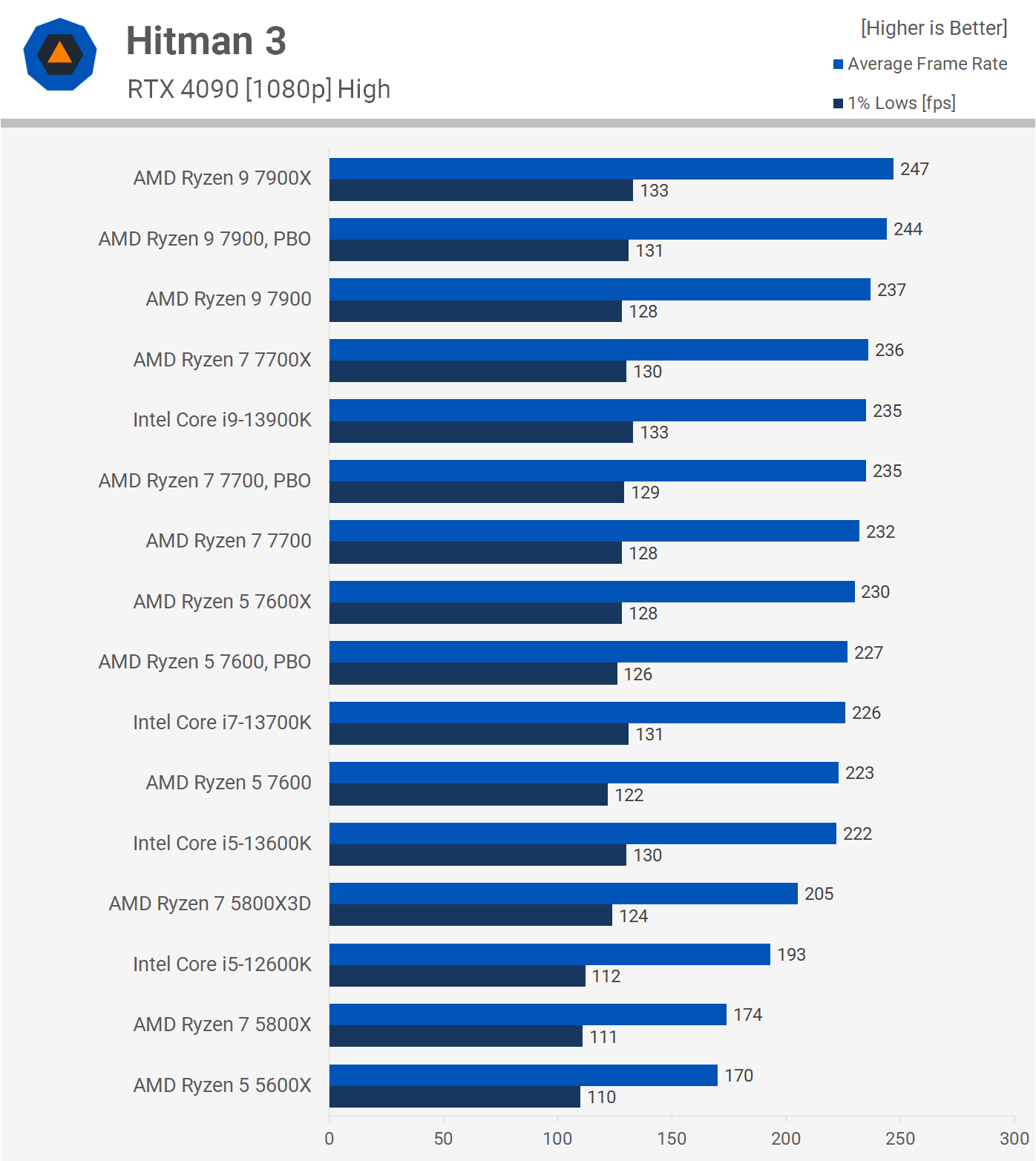
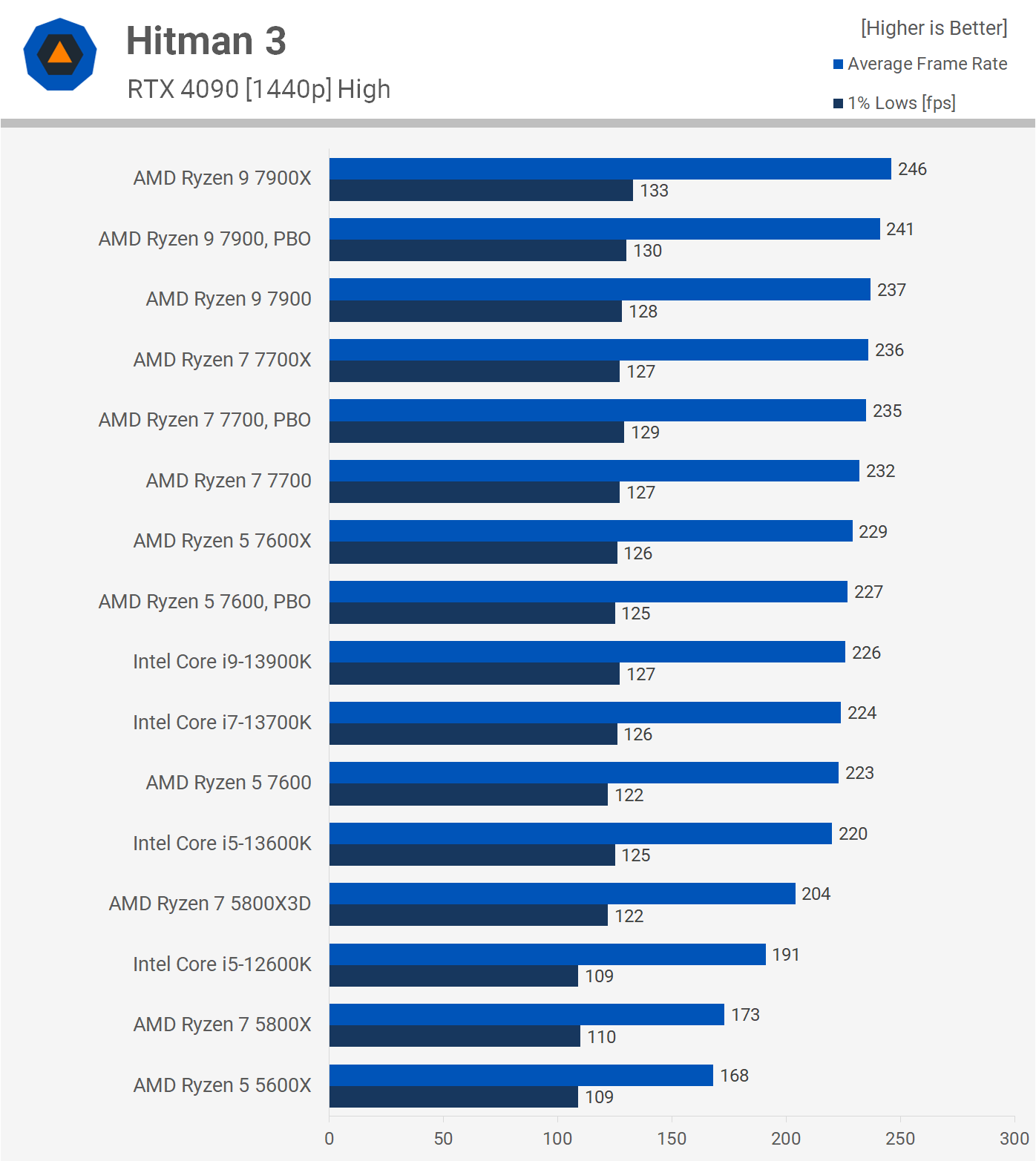
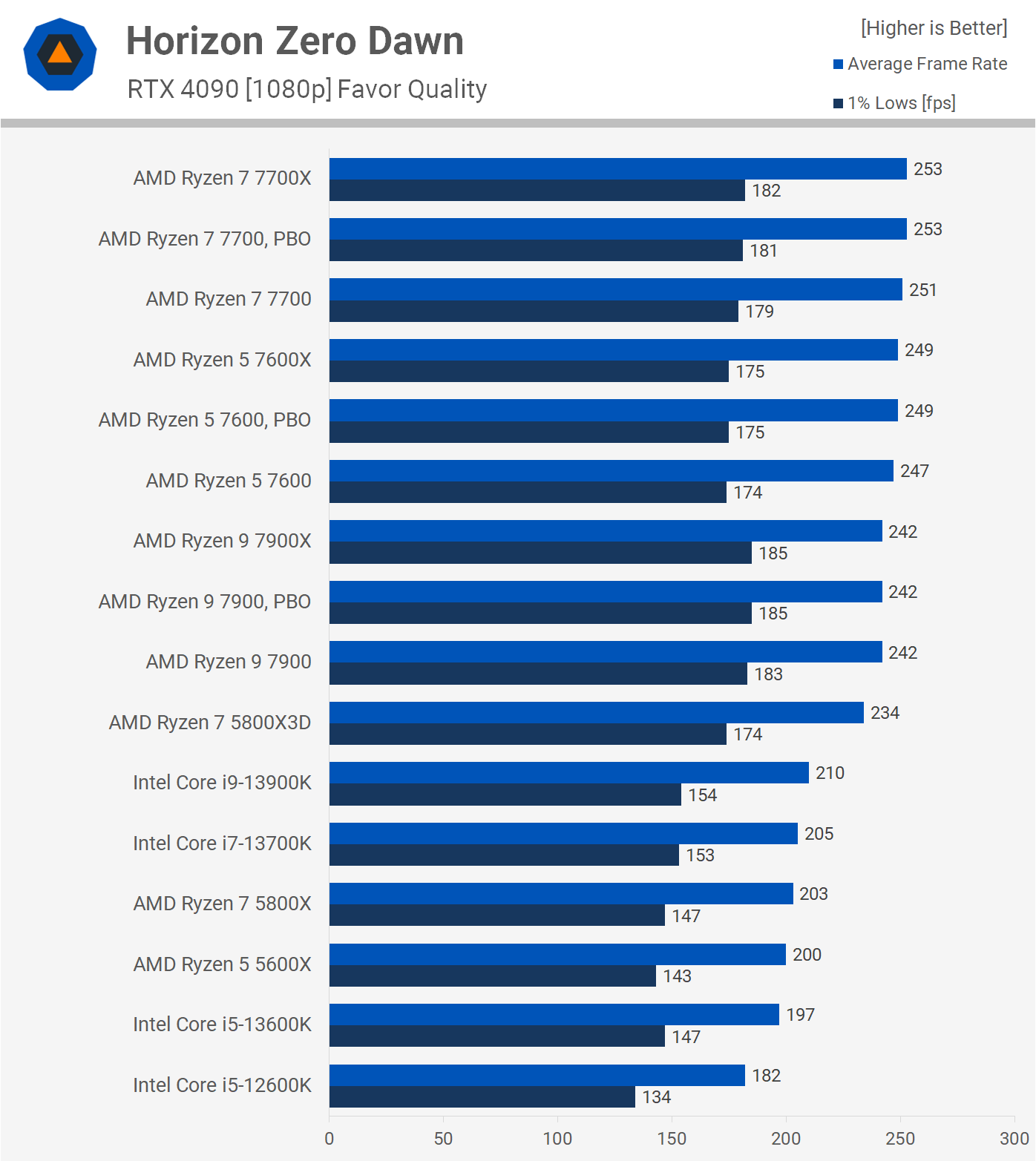
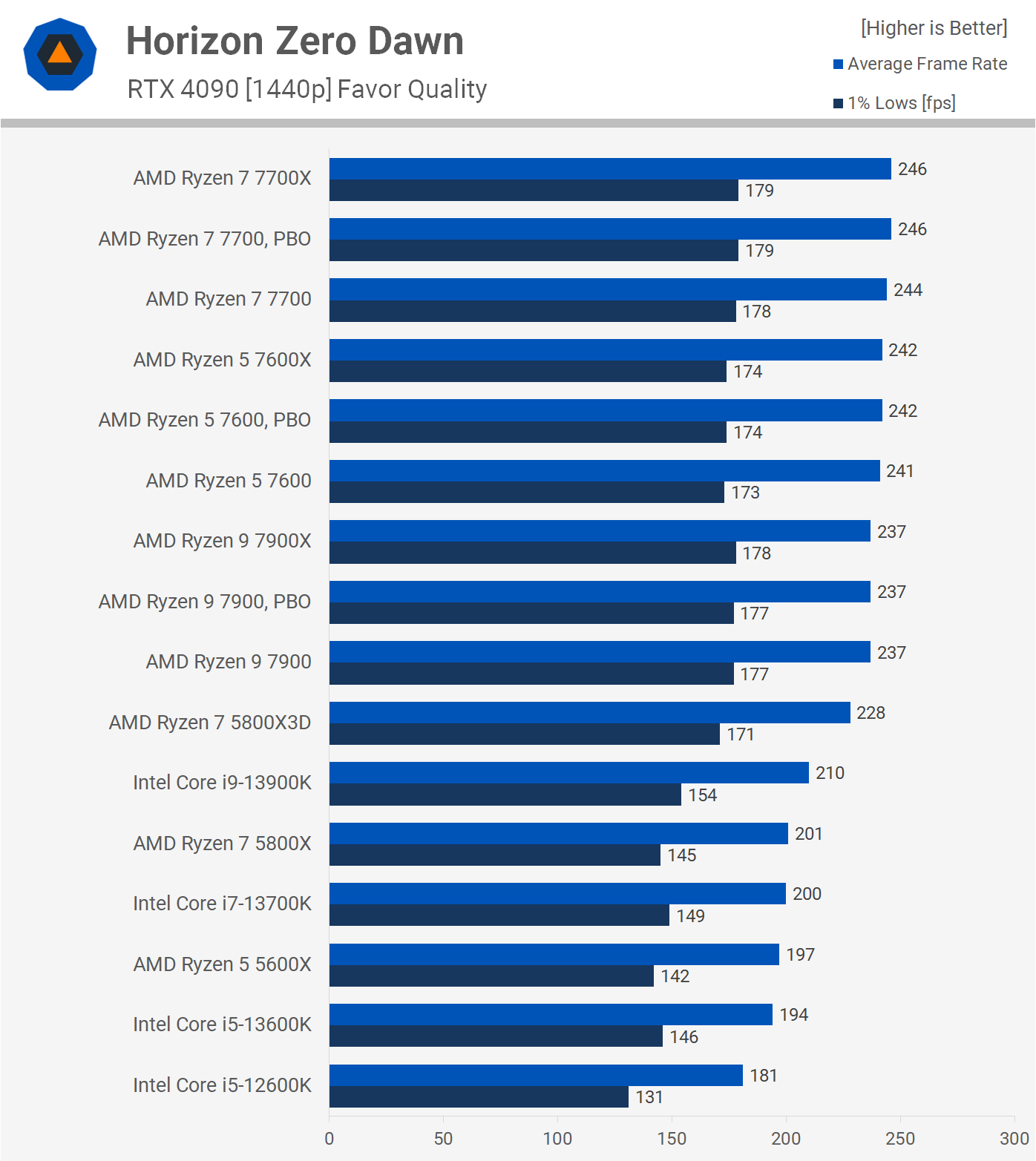
The Horizon Zero Dawn performance is even closer between X and non-X models, the 7900 and 7900X delivered identical performance, while the 7600X was 1% faster than the 7600.
It’s the same at 1440p, so at least in this game it doesn’t matter which model you use, performance will be the same.
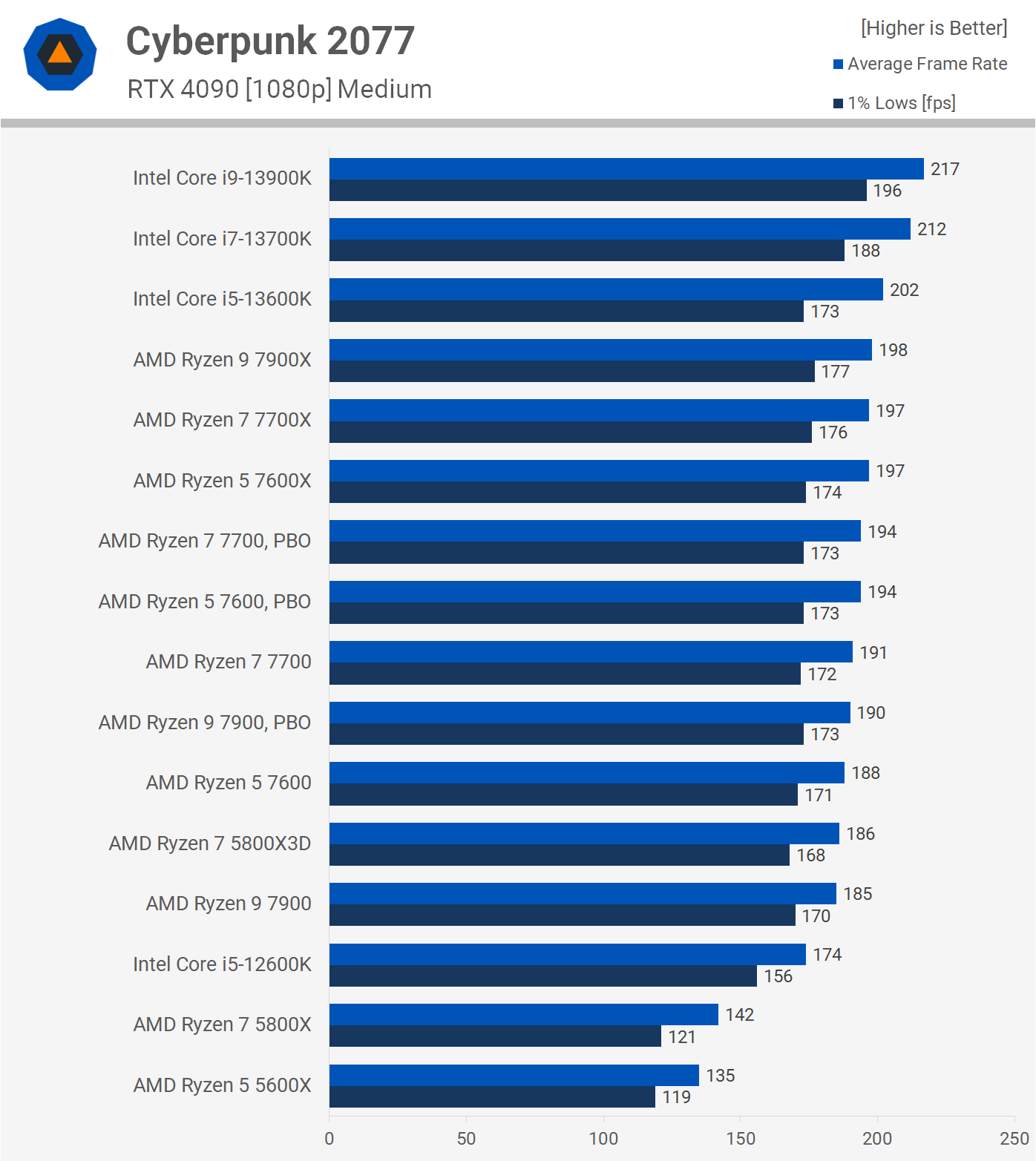
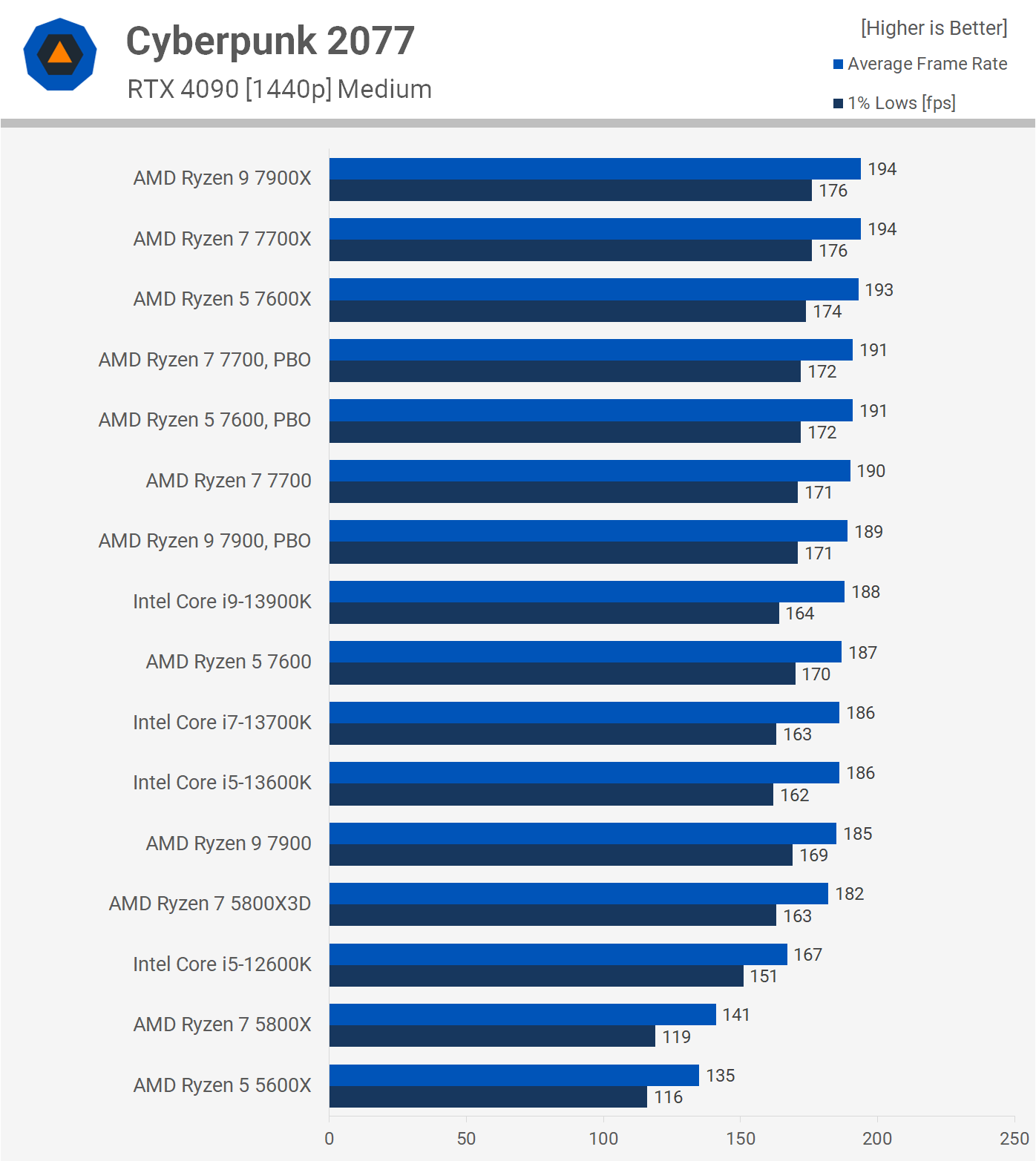
Cyberpunk 2077 is very CPU demanding, and therefore utilizes these parts well, it’s also sensitive to frequency, so we are seeing some variation in the results. That said, the 7900 vs 7900X battle which sees the largest difference in operating behavior only resulted in a 7% performance delta.
That margin is reduced to just 3% for the 7700 vs 7700X matchup, and 5% for the 7600 vs 7600X.
10 Game Average Performance
We tested 10 games in total, starting with the 1080p data we see that the 7600 was on average 4% slower than the 7600X, the 7700 just 5% slower than the 7700X, and the 7900 4% slower than the 7900X in games.
These aren’t big margins and for those who care about productivity performance will find these non-X CPUs to make a lot more sense, given they’re significantly more efficient and operate at much lower temperatures.
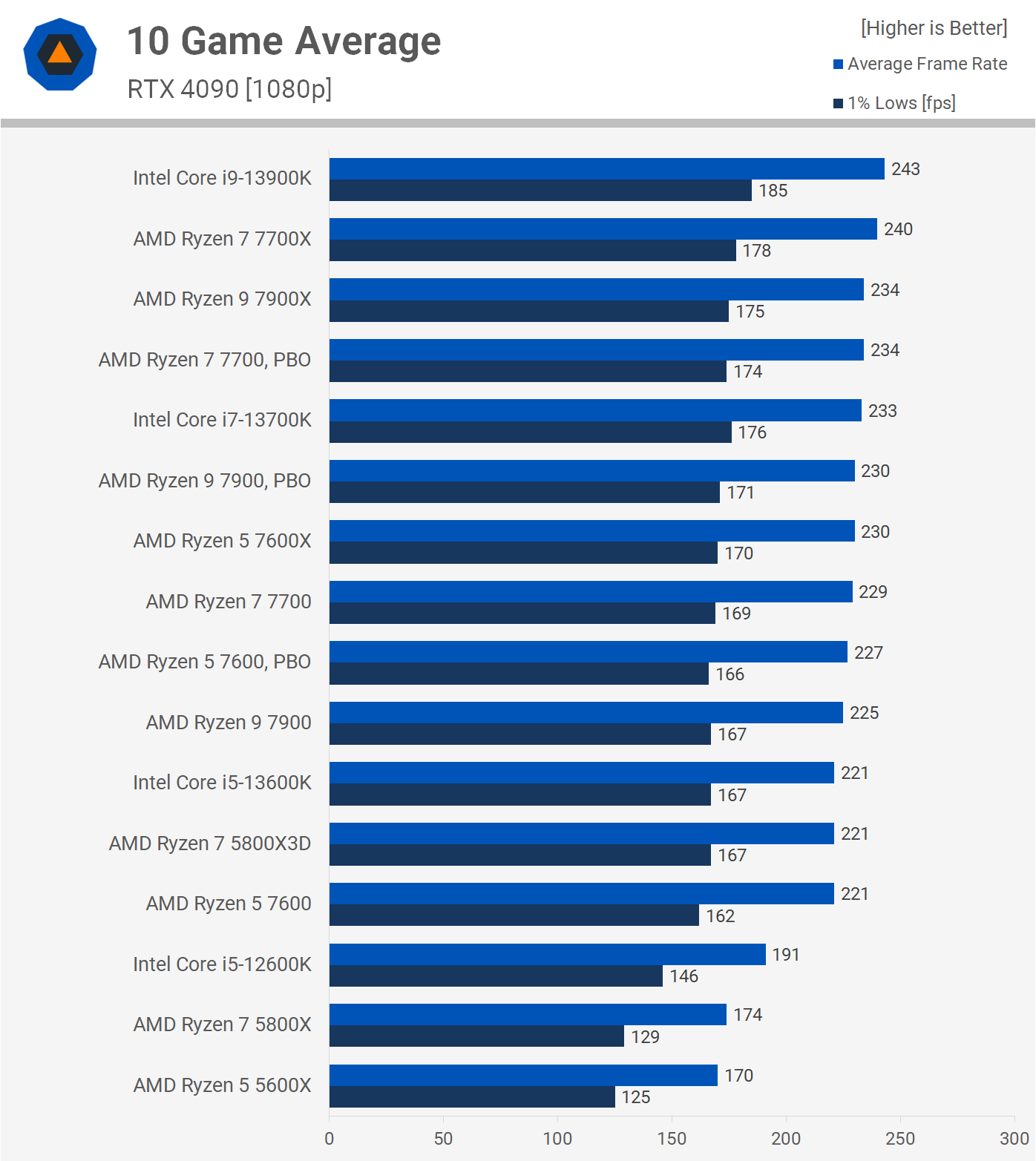
But you can also see why AMD went about things the way they did. These non-X parts don’t look nearly as impressive on a graph when compared to Intel 13th-gen range. The 7700X is just a few frames slower than the 13900K and finds itself in second place, the 7700 which is just a few percent slower is a mid-field contender in this graph, trailing the 13700K by a slim margin.
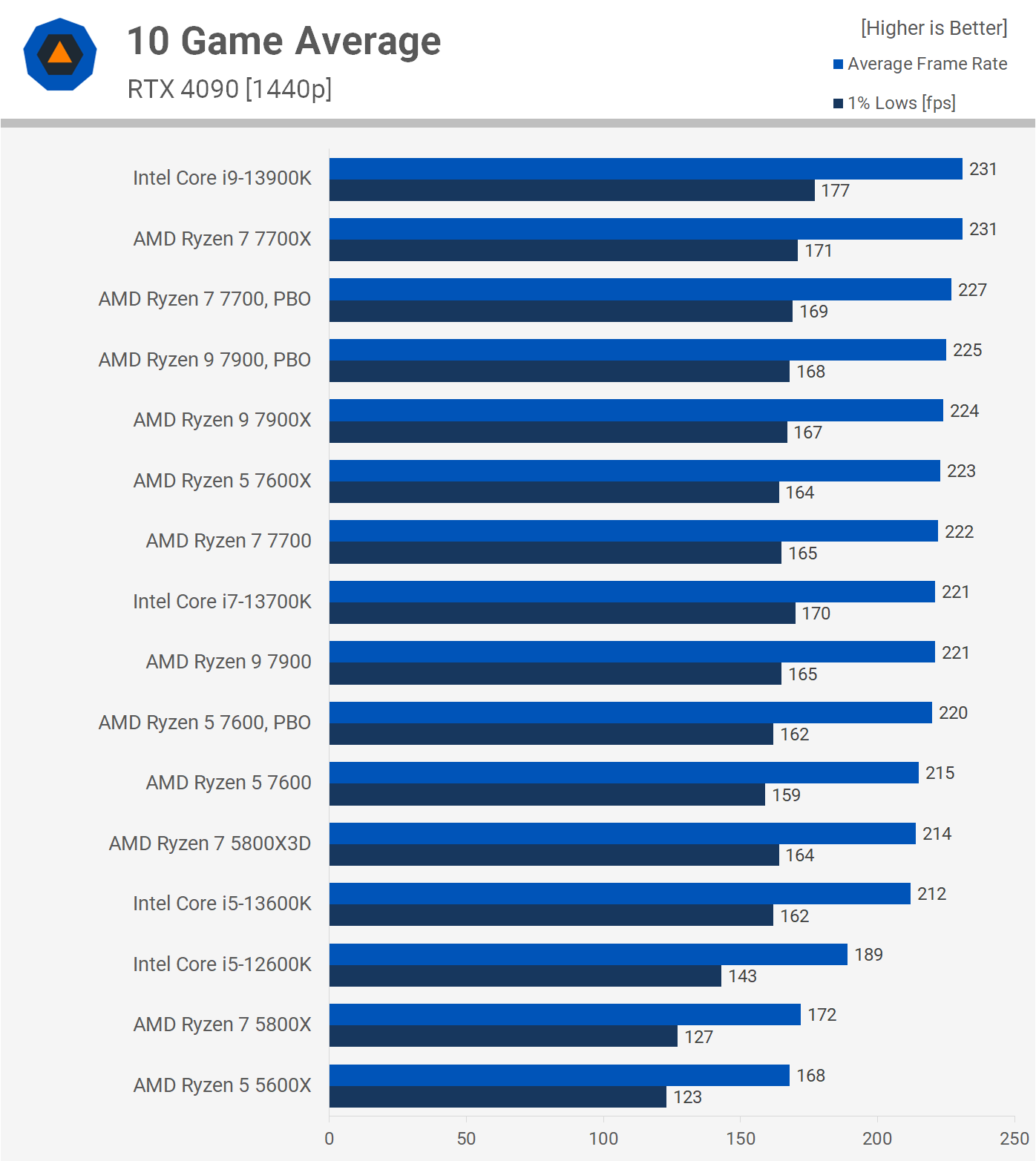
As you’d expect when slightly more GPU bound — and I really do mean slightly — the margins closed up a little at 1440p. The 7700 is now 4% slower than the 7700X, for a 1% decrease when compared to the 1080p results. Overall the non-X parts are at most 4% slower when gaming.
Cooling
Taking a quick look at cooling performance using the supplied coolers, we’ll start with the 7600 using the Wraith Stealth. When placed under an all-core workload in Cinebench for an hour, installed inside an ATX case with a room temperature of 21c, this combo peaked at 97c, which is very hot. That said, we know Zen 4 processors target 95c and are designed to run at that temperature according to AMD, and we saw no evidence of throttling under these conditions, so the 7600 performed as expected. For reference under the same test conditions the 7600 peaked at 78c with a 360mm AIO.
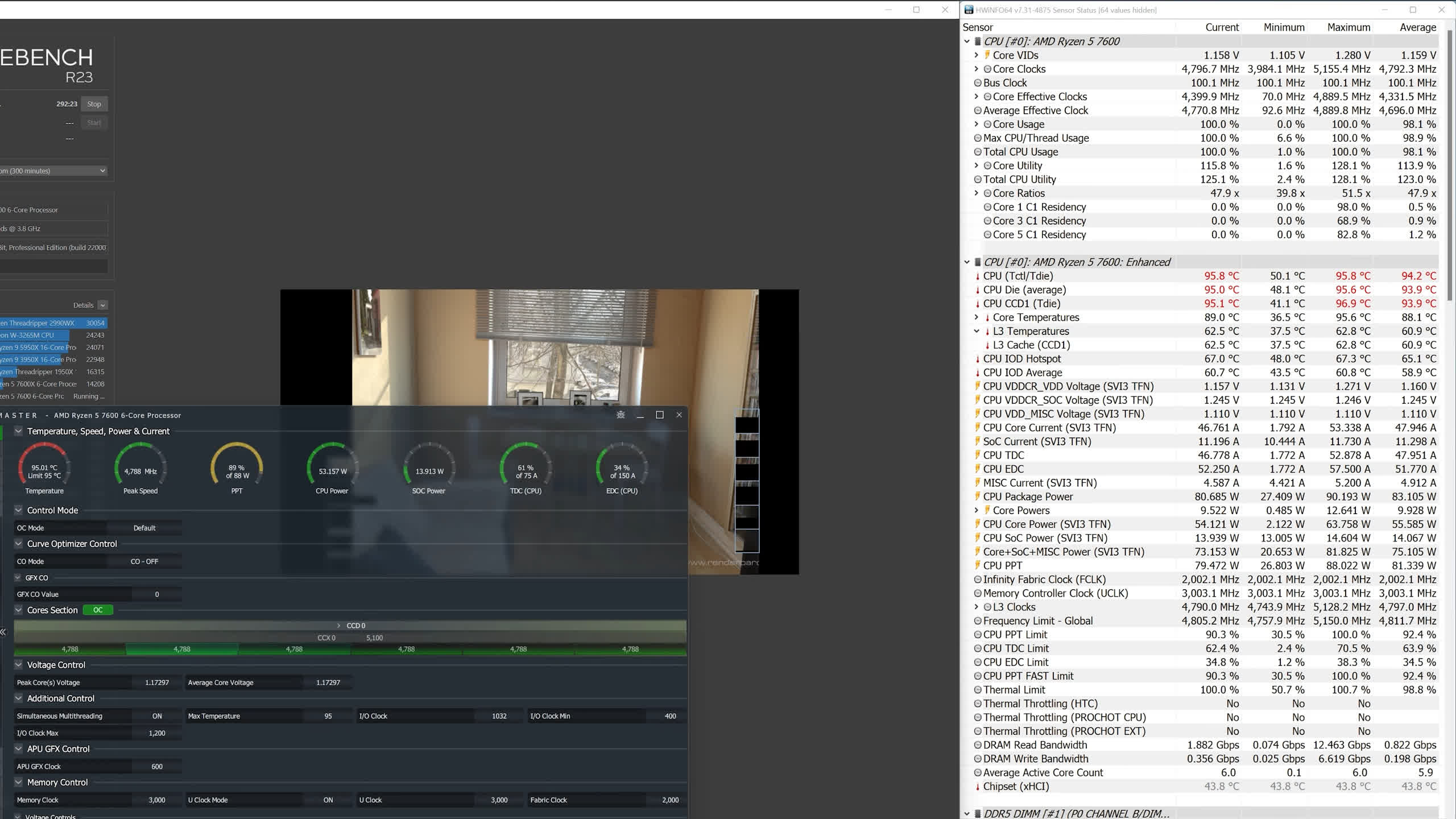
Next we have the 7700 with the Wraith Prism, which is a far more impressive cooler and the results here are far better than what we saw with the 7600/Stealth combo. With the Prism the 7700 peaked at 79c, which is well below the 95c TjMAX. That’s a great result given the 360mm AIO saw a peak temperature of 73c.
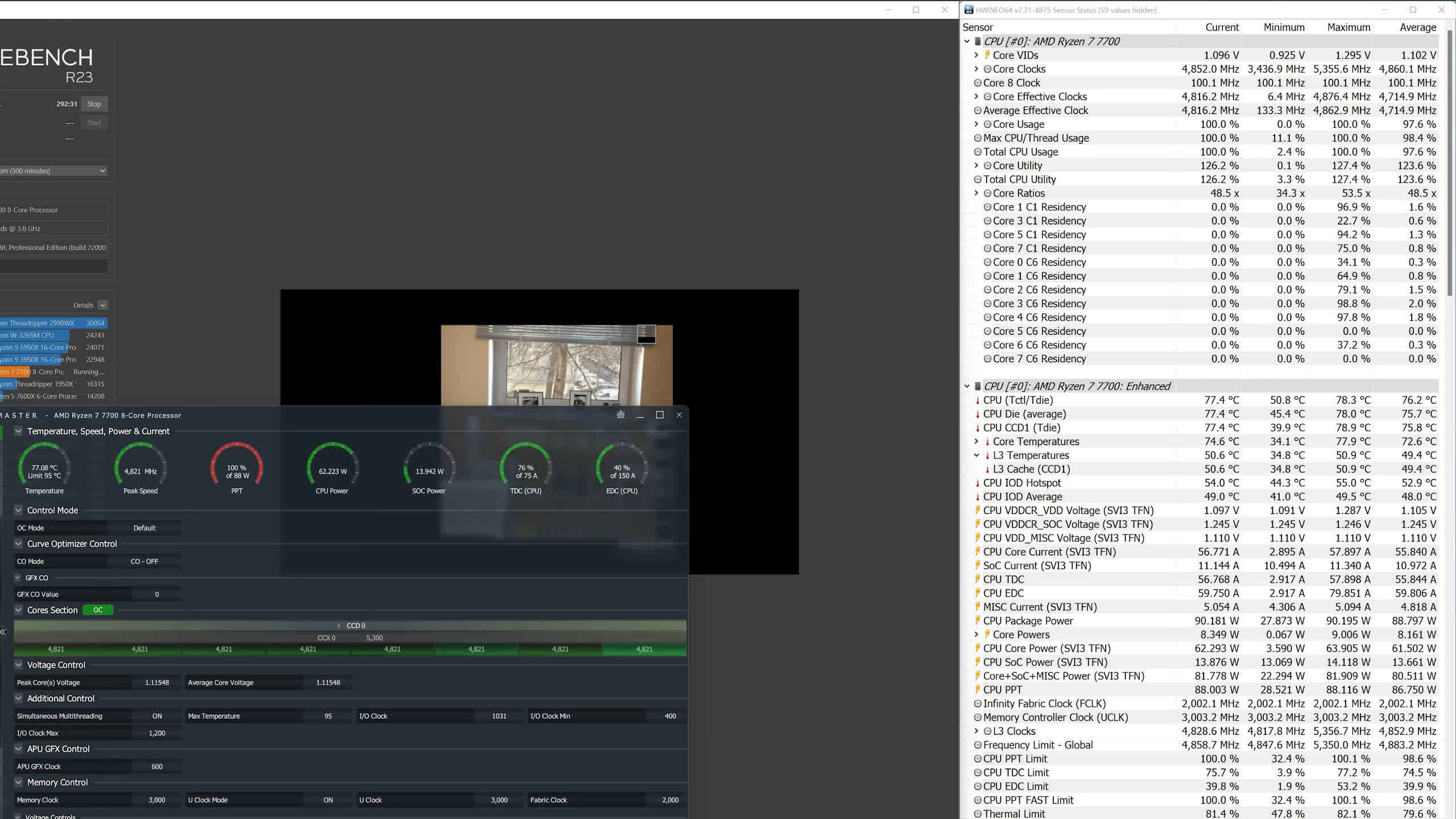
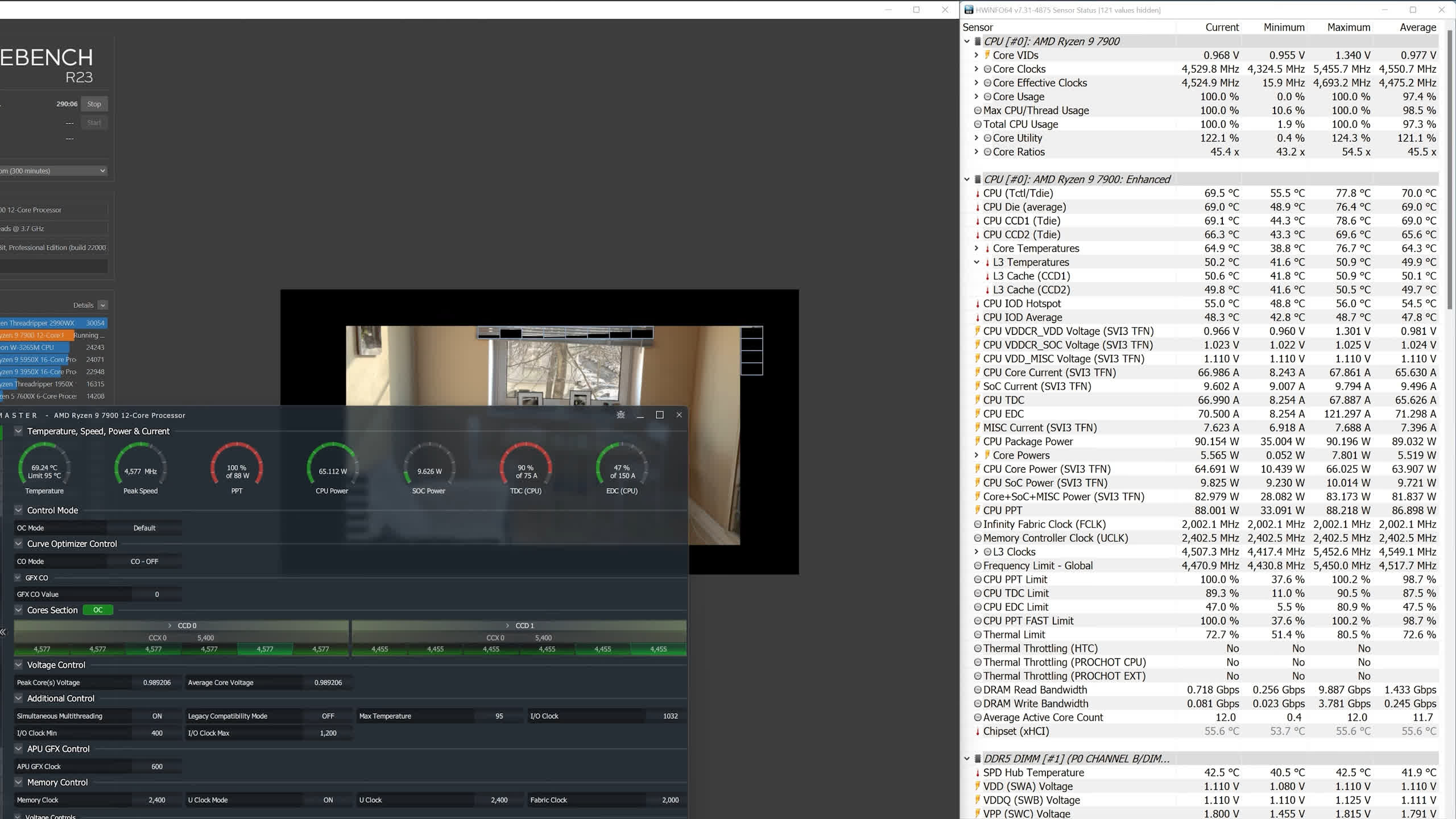
Then finally we have the 7900 which again comes with the Wraith Prism. Again, we saw a peak temperature of 79c, which is a another good result and for reference the 7900 peaked at 70c using the 360mm AIO.
Reevaluating AM4: Cost per Frame
AMD’s new non-X Zen 4 CPUs are a lot like non-X Zen 3 CPUs, which were a lot like the non-X Zen 2 CPUs, which were… okay we’ll stop. Point is, they are exactly what you were probably expecting, more affordable and ever so slightly slower versions of their X counterparts.
We’ve always recommended you buy the non-X versions, and we’ve done this for a few reasons. First, of course, they’re generally cheaper and deliver comparable performance. They’re also more efficient and unlocked, so you can overclock them to achieve full performance, and they typically come with a box cooler, which you can sell on eBay if you don’t need it. The Wraith Prism sells for around $30-40 which is crazy considering you can get a good quality tower style cooler for that price.
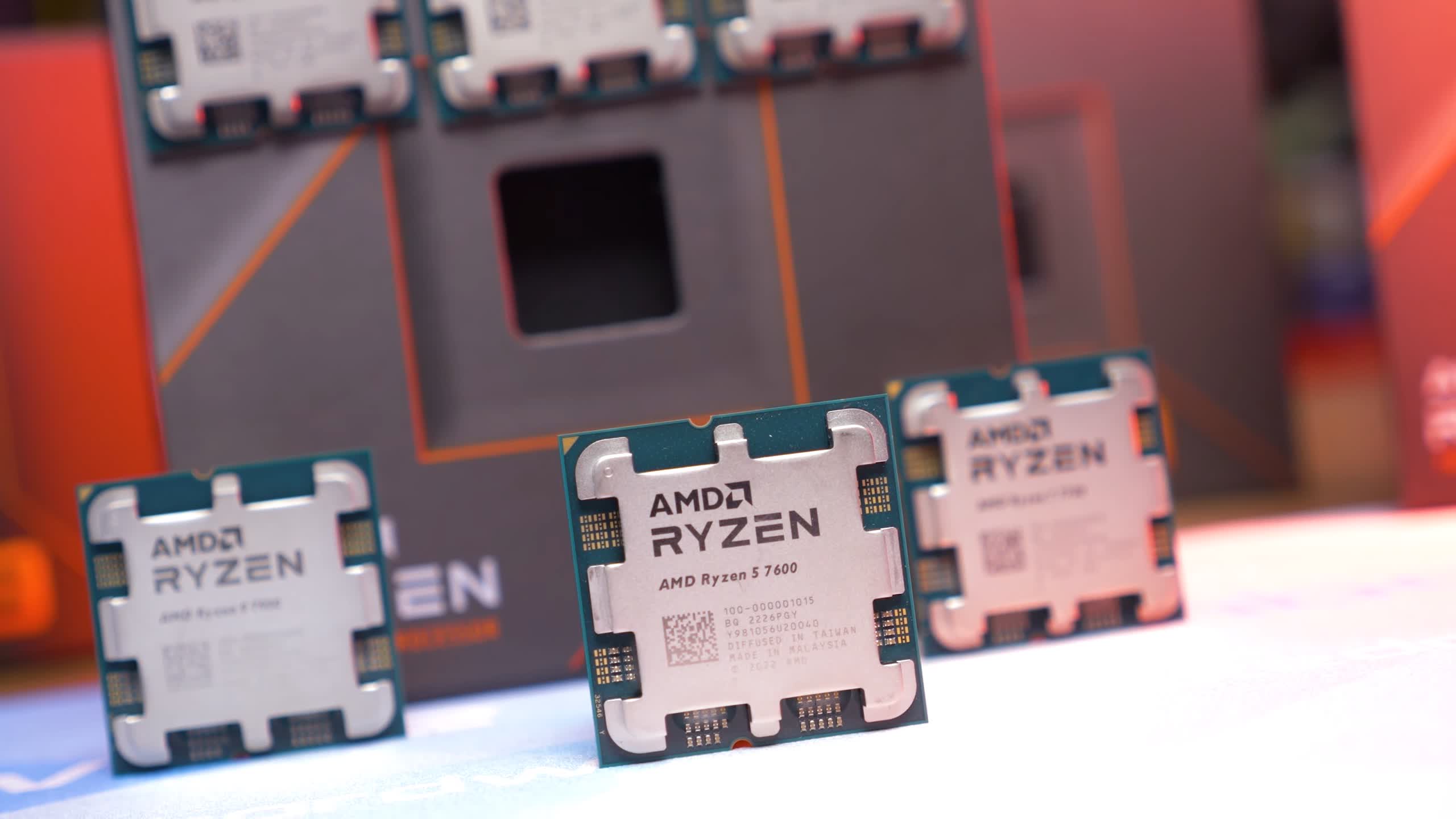
So assuming the non-X parts are at least $20 cheaper, we’d probably go that way, sell the cooler and pocket the difference. We’re also a lot happier with how these non-X models behave out of the box, they’re significantly more efficient and if you want to overclock them for maximum performance — power efficiency be damned, well you can still do that.
Since we are “re-reviewing Zen 4” we thought we might as well create an updated cost per frame analysis, so let’s do that. Before we do though, a bucket list of disclaimers…
- The angle here is new system builders or those upgrading their entire platform. So not someone who is already well invested in a modern or current platform such as AM4 or LGA 1700.
- If you’re already on AM4, you’d probably just opt for a 5700X or 5800X3D, and if on LGA 1700 with a lower-end 12th-gen part you’d probably just look at a 13th-gen upgrade.
- For this cost per frame analysis we’ll be including the current retail price of the CPU, a 32GB kit of memory, and a budget motherboard
- Because this is a new complete platform upgrade value analysis, we’re focusing exclusively on DDR5 memory for the platforms that support it.
- For budget builds, DDR4 still has its place, but that’s not what we’re looking for today. That said, the AM4 CPUs were obviously tested with DDR4 memory as they don’t support DDR5, and here we’re using DDR4-3600 CL16 memory at $110 for a 32GB kit. You could save even more money on a CL18 kit for $80, but that’s quite a bit slower than what we tested and would really throw off the numbers.
Given the AM4 CPUs are getting slightly slower and much cheaper DDR4 compared to what we actually tested with, we’re doing the same for the DDR5 configurations, opting for $150 DDR5-6000 and we’ve given the Raptor Lake CPUs the same price despite the cheapest DDR4-6400 memory coming in at $175. We’d expect to see a similar performance decline for the Zen 4 and Raptor Lake CPUs using DDR5-6000 CL36 memory, compared to what is shown in this review. If that doesn’t sound fair, please keep in mind that the DDR5 memory used to test the AMD and Intel CPUs in this review both cost around $170 – $180.
Because we’re using DDR5 for the Intel 12th and 13th gen CPUs as you should when building a brand new system, the cheapest LGA 1700 boards available supporting DDR5 memory cost $160 for Z690, $170 for B670, $190 for B660 and $200 for Z790, so let’s go with the cheap Z690 option at $160.
For AM5 the cheapest B650 boards are also $160 with X670 priced well north of $200. Then for AM4 you have a mountain of options and there are plenty of solid options for as little as $120. With all of that out of the way, let’s go over the data…

Based on current retail pricing, it will come as no surprise to learn that the Ryzen 5 5600 offers the best value as it can be had for as little as $135, although stock for it seems to be drying up.
Now, looking at the 7600X, it’s interesting to see that at $250, it offers the same value as the 7600, ignoring that it doesn’t come with a cooler. We do expect the 7600X to rise in price back towards the $300 MSRP now that the 7600 is available.
In terms of value, both slaughter the Core i5-13600K which currently costs $320. You could reduce the cost of the Core i5 build by ~$100 with a cheaper DDR4 B660 board and memory, but even if we take the same 221 fps that would only place it roughly on par with the 7600 in terms of value, and we know from previous testing that the 13600K is 8% slower on average using affordable DDR4 memory. So it would seem AMD has Intel beat on value for the 7600/7600X vs 13600K battle for now.
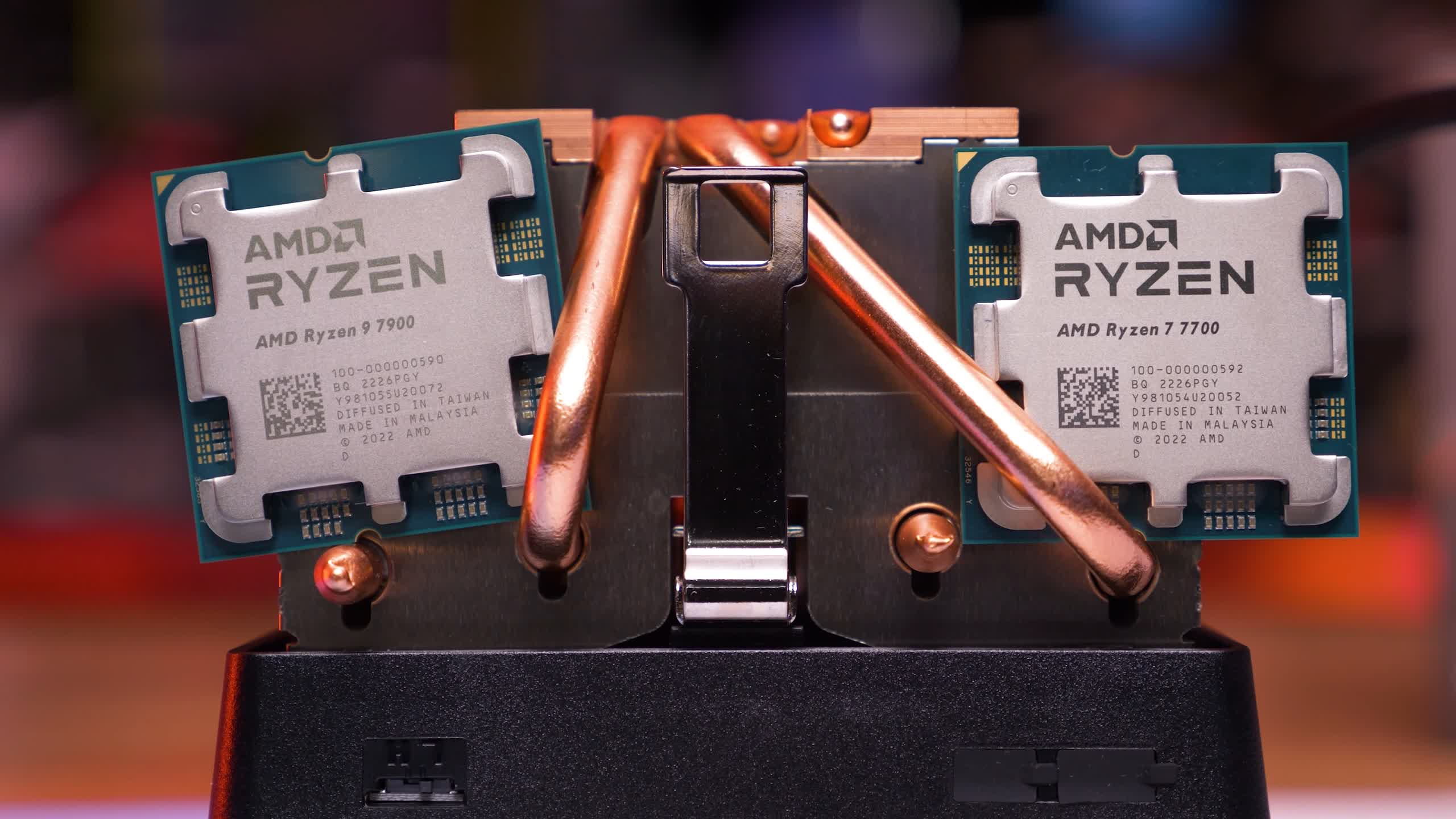
The Ryzen 7 7700 is interesting because again it’s slightly worse value than the 7700X which is currently selling for just $345, but could head back towards the MSRP now that the 7700 is on the market. For those building a new system the 7700X makes more sense than any of the 8-core AM4 options, including the 5800X3D as you’re getting slightly better performance at a similar cost per frame, on a newer platform, supporting DDR5 with an upgrade path.
For gamers the 7700 also beats the 13700K in terms of value, offering a similar level of performance at a lower price point. But if productivity is a priority, then ignore that as the 13700K might be the faster option depending on the workload.
The Ryzen 9 7900 is a nice CPU, but it doesn’t make much sense for gamers. You’re much better off with the single CCD Ryzen 7 parts, and for productivity you might as well get the 7950X, or 13900K, though power usage and thermal issues make the Core i9 a lot less practical as a productivity CPU.
Bottom Line
What’s clear is that AMD Zen 4’s position has been strengthened since our launch reviews. The more affordable 65w parts are also more sensible out of the box, and with much more affordable B650 motherboards it means the platform is now viable and in our opinion the obvious choice over AM4 for new system builders, outside of budget builds.
This was already true before the arrival of these non-X 65w parts as AMD had cut pricing aggressively over the past few months, but the new CPUs make it all official. There’s a chance the original X-parts head back towards their respective MSRPs (and become more expensive), but at that point we’d simply ignore them and just go for the non-X 65w models instead.
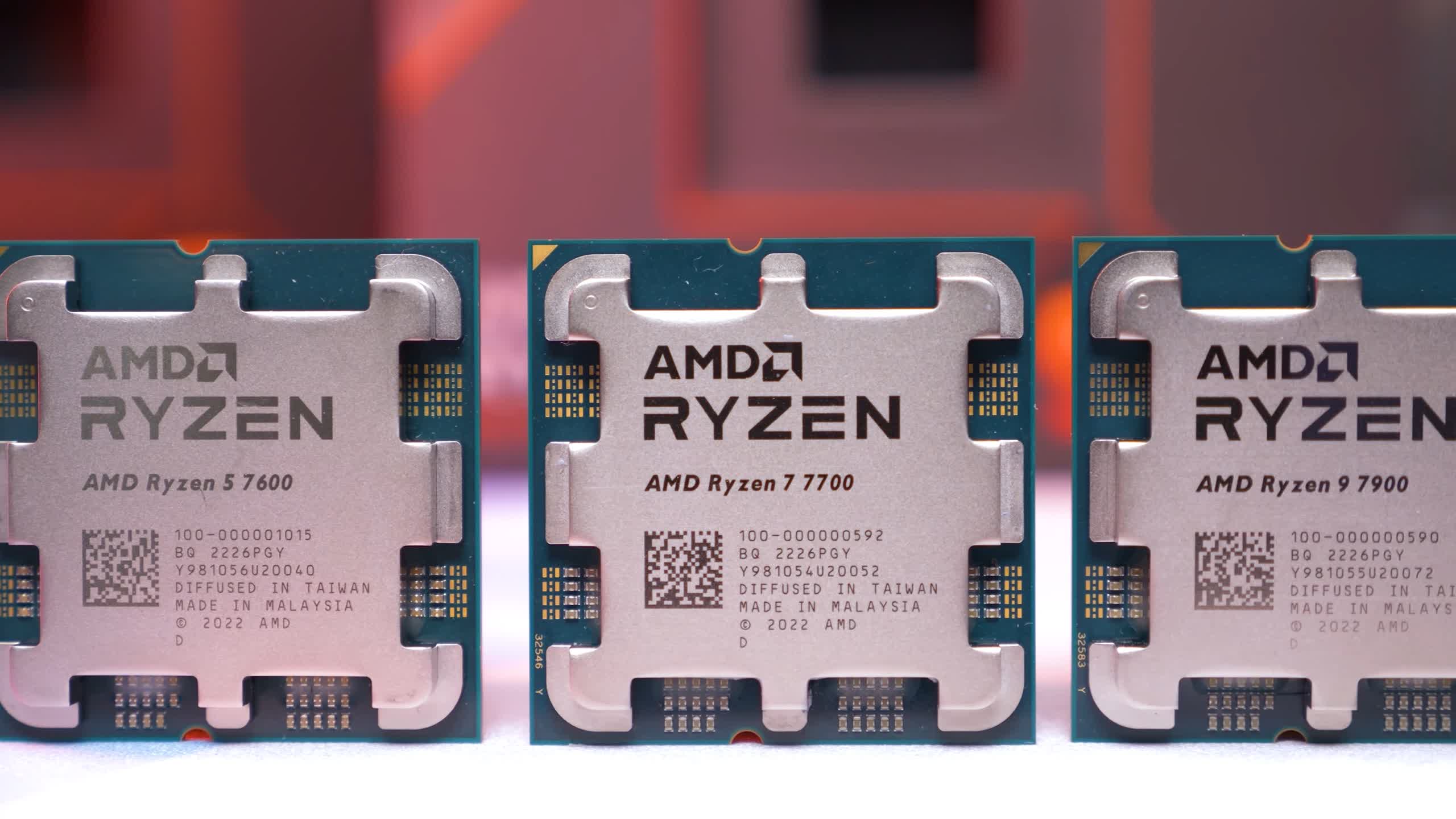
It’s also worth mentioning that hardcore gamers will want to do nothing until next month, when we get to see what the 3D V-Cache versions of the 7800X3D, 7900X3D and 7950X3D have to offer. Those parts could shake up the market and even force Intel into aggressive price cuts, so fingers crossed on that one.
Last but not least, we’ve already purchased the Core i3-13100, Core i5-13400, Core i5-13500 and Core i7-13700 CPUs that Intel announced at CES but haven’t sampled to reviewers. We’ve also got some new Intel B760 boards, so expect all that content soon.

